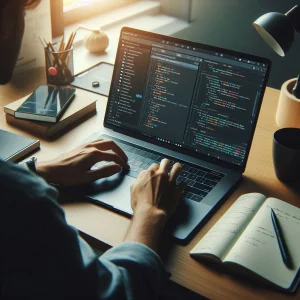Remote auditing has emerged as a transformative approach in the field of internal auditing, leveraging technology to conduct audits without the need for physical presence at the audit site. This method is defined as the process of performing audits using digital tools and communication technologies, allowing auditors to assess and verify information from a distance. The importance of remote auditing lies in its ability to maintain audit integrity and efficiency while adapting to the evolving landscape of work, particularly in light of recent global events.
The shift towards remote work in auditing has been significantly accelerated by the COVID-19 pandemic, which necessitated a reevaluation of traditional audit practices. As organizations were compelled to implement remote work policies, auditors had to pivot quickly to ensure compliance and oversight without the benefit of on-site visits. This transition has highlighted the necessity for robust remote auditing practices, enabling firms to continue their operations seamlessly despite physical restrictions.
However, the move to remote auditing has not been without its challenges. Traditional audit processes often rely on in-person interactions and physical inspections, which can be difficult to replicate in a virtual environment. Issues such as technology compatibility, communication barriers, and the need for effective documentation have surfaced as significant hurdles. Additionally, ensuring the security of sensitive data during remote audits poses a critical concern that organizations must address to maintain trust and compliance.
Remote auditing represents a vital evolution in the internal audit landscape, driven by technological advancements and the need for flexibility in a rapidly changing world. As audit technology professionals, understanding the tools and strategies that facilitate effective remote audits is essential for navigating this new terrain and ensuring the continued success of audit functions.
The Role of Technology in Remote Auditing
In the evolving landscape of internal auditing, technology plays a pivotal role in facilitating effective remote audits. As organizations adapt to new operational realities, leveraging advanced tools and platforms has become essential for maintaining audit integrity and efficiency. Here are some key points highlighting the significance of technology in remote auditing:
- Enhancing Collaboration and Communication: Technology enables seamless collaboration among audit teams and stakeholders, regardless of their physical locations. Tools such as video conferencing software and cloud-based platforms allow auditors to conduct meetings, share documents, and discuss findings in real-time. This level of interaction is crucial for ensuring that all parties are aligned and informed throughout the audit process, fostering a more transparent and efficient workflow [1][4].
- Overcoming Physical Limitations: The shift to remote auditing has necessitated the use of technology to bridge the gap created by physical distance. With travel restrictions and the need for social distancing, traditional on-site audits have become challenging. Remote auditing tools, including smart devices and drones, allow auditors to gather necessary data and conduct assessments without being physically present. This capability not only ensures continuity in audit operations but also expands the geographical reach of audit teams [10][15].
- Benefits of Incorporating Technology: The integration of technology into the audit process offers numerous advantages. It enhances the accuracy and speed of data collection and analysis, allowing auditors to focus on critical areas of risk and compliance. Additionally, technology facilitates the documentation and tracking of audit findings, making it easier to verify and validate results. By utilizing digital tools, auditors can streamline their workflows, reduce manual errors, and improve overall audit quality [3][11].
Technology serves as the backbone of remote auditing, enabling effective collaboration, overcoming physical barriers, and enhancing the overall audit process. As the demand for remote audits continues to grow, embracing these technological advancements will be crucial for audit professionals aiming to maintain high standards of performance and compliance in their work.
Key Technology Tools for Remote Audits
In the evolving landscape of internal auditing, the shift towards remote audits has necessitated the adoption of various technology tools that enhance efficiency and effectiveness. Here’s an overview of essential tools that facilitate remote audits, catering specifically to audit technology professionals.
- Video Conferencing Tools: Platforms such as Zoom and Microsoft Teams have become indispensable for conducting virtual meetings. These tools allow audit teams to maintain clear and consistent communication with stakeholders, ensuring that discussions are productive and that all parties are engaged throughout the audit process. The ability to share screens and record sessions further enhances collaboration and documentation during audits [2][4].
- Document Sharing and Collaboration Platforms: Tools like Google Drive and Dropbox enable seamless document sharing and collaboration among audit team members and clients. These platforms provide a centralized location for storing and accessing audit-related documents, which is crucial for maintaining organization and ensuring that all team members have access to the latest information. This is particularly important in remote settings where physical document exchange is not feasible [3][10].
- Audit Management Software: Solutions such as AuditBoard and TeamMate streamline the auditing process by offering features that facilitate planning, execution, and reporting of audits. These tools help in tracking audit progress, managing workflows, and ensuring compliance with auditing standards. By automating various aspects of the audit process, they allow auditors to focus on analysis and insights rather than administrative tasks [5][15].
- Data Analytics Tools: Tools like IDEA and ACL are essential for analyzing large datasets remotely. These data analytics platforms enable auditors to perform complex analyses, identify trends, and uncover anomalies in financial data without the need for on-site access. The ability to conduct thorough data analysis remotely enhances the quality of audits and supports informed decision-making [6][9].
The integration of these technology tools into the remote auditing process not only enhances efficiency but also ensures that audit quality is maintained. As the auditing profession continues to adapt to a digital world, leveraging these tools will be crucial for audit technology professionals aiming to deliver effective and comprehensive audits.
Best Practices for Remote Auditing with Technology
In the evolving landscape of internal auditing, the integration of technology has become paramount, especially in the context of remote audits. As audit technology professionals seek to enhance their practices, implementing effective strategies is essential for leveraging technology to its fullest potential. Here are some best practices for conducting remote audits using technology:
- Establishing Clear Communication Protocols: Effective communication is the backbone of successful remote audits. Audit teams should develop clear protocols that outline how information will be shared, the frequency of updates, and the channels to be used. This ensures that all team members are aligned and can address issues promptly, fostering a collaborative environment even when working remotely [3][12].
- Setting Up Secure Access to Sensitive Information and Data: Security is a critical concern in remote auditing. Organizations must implement robust security measures to protect sensitive information. This includes using secure cloud storage solutions, encrypted communication channels, and multi-factor authentication to ensure that only authorized personnel can access confidential data. By prioritizing security, audit teams can mitigate risks associated with remote access [5][11].
- Creating Structured Workflows to Facilitate Real-Time Collaboration: To enhance efficiency, audit teams should establish structured workflows that allow for real-time collaboration. Utilizing project management tools and shared digital platforms can streamline the audit process, enabling team members to track progress, share documents, and provide feedback instantaneously. This approach not only improves productivity but also ensures that all team members are engaged and informed throughout the audit [4][9].
- Regular Training and Updates for Audit Teams on New Tools and Technologies: The rapid advancement of technology necessitates ongoing training for audit professionals. Regular workshops and training sessions should be conducted to familiarize teams with the latest tools and technologies relevant to remote auditing. This not only enhances their skill set but also ensures that they are equipped to utilize new features effectively, ultimately leading to improved audit quality [2][13].
By implementing these best practices, audit technology professionals can significantly enhance the effectiveness of remote audits. The strategic use of technology not only streamlines processes but also fosters a culture of collaboration and security, which is essential in today’s digital auditing environment.
Challenges and Considerations in Remote Auditing
As remote auditing becomes increasingly prevalent, it is essential for audit technology professionals to understand the challenges and considerations that accompany this shift. Here are some key points to address potential pitfalls and strategies for mitigation:
- Identifying Cybersecurity Risks and Ensuring Data Protection: Cybersecurity remains a significant concern in remote auditing. Cyber actors often exploit poor security configurations and weak controls, which can lead to data breaches and compliance issues. Organizations must implement robust security measures, such as multi-factor authentication and regular security audits, to protect sensitive data during remote audits [10][13]. Additionally, adopting Zero Trust principles can enhance security by ensuring that all users, whether inside or outside the organization, are verified before accessing systems [11].
- Managing Time Zones and Scheduling Conflicts for Global Teams: Coordinating audits across different time zones can pose logistical challenges. To mitigate scheduling conflicts, organizations can utilize scheduling tools that allow for real-time availability updates and automated reminders. Establishing clear communication protocols and flexible working hours can also help accommodate team members in various locations, ensuring that all stakeholders can participate effectively in the audit process [2].
- Overcoming Resistance to Technology Adoption Among Some Audit Professionals: Resistance to adopting new technologies can hinder the effectiveness of remote audits. To address this, organizations should invest in training programs that emphasize the benefits of technology in auditing, such as improved efficiency and accuracy. Encouraging a culture of continuous learning and providing support during the transition can help alleviate concerns and foster acceptance among audit professionals.
- Ensuring Compliance with Regulatory Requirements in a Remote Environment: Compliance with regulatory standards is crucial, even in a remote setting. Auditors must stay informed about the evolving regulatory landscape and ensure that their remote auditing practices align with relevant laws and standards. This may involve regular updates to audit protocols and leveraging technology solutions that facilitate compliance monitoring and reporting [1][3]. Utilizing tools that provide real-time data analysis can also enhance compliance efforts by offering ongoing insights into financial activities [4].
By addressing these challenges and implementing effective strategies, audit technology professionals can enhance the effectiveness of remote audits, ensuring that they meet both organizational and regulatory requirements while leveraging the latest technological advancements.
Future Trends in Remote Auditing Technology
As the landscape of internal auditing continues to evolve, the integration of advanced technologies is becoming increasingly vital for effective remote audits. This section explores the latest tools and trends that are shaping the future of remote auditing, particularly focusing on the potential of artificial intelligence, blockchain technology, and cloud-based solutions.
1. Potential of Artificial Intelligence and Machine Learning in Audit Processes
Artificial intelligence (AI) and machine learning (ML) are set to revolutionize the audit profession by automating routine tasks and enhancing data analysis capabilities. These technologies enable auditors to:
- Analyze Large Data Sets: AI can process vast amounts of data quickly, identifying patterns and anomalies that may not be visible through traditional methods. This capability allows for more thorough and efficient audits, reducing the time spent on data collection and analysis [2][12].
- Predictive Analytics: By leveraging machine learning algorithms, auditors can forecast potential risks and issues before they arise, allowing for proactive measures to be taken [13]. This shift towards predictive analytics enhances the overall effectiveness of audits.
2. Integration of Blockchain Technology for Enhanced Transparency
Blockchain technology offers significant advantages for remote auditing, particularly in terms of transparency and security. Key benefits include:
- Immutable Records: Blockchain provides a secure and tamper-proof ledger of transactions, which can be invaluable for auditors seeking to verify the integrity of financial data [7]. This technology ensures that all changes to data are recorded and traceable, enhancing trust in the audit process.
- Streamlined Processes: The integration of blockchain can simplify audit procedures by automating verification processes and reducing the need for extensive documentation [3]. This efficiency is particularly beneficial in remote auditing scenarios where access to physical documents may be limited.
3. The Rise of Cloud-Based Solutions for Greater Flexibility and Accessibility
Cloud technology is transforming the way audits are conducted, offering numerous advantages for remote auditing:
- Real-Time Collaboration: Cloud-based platforms allow auditors to access client data remotely, collaborate with team members in real-time, and store audit documentation securely [9][10]. This flexibility is crucial for teams working in different locations, enabling seamless communication and coordination.
- Scalability and Cost-Effectiveness: Cloud solutions can be scaled to meet the needs of various audit projects, providing organizations with the ability to adjust resources as necessary without significant upfront investments [6]. This adaptability is essential in a rapidly changing business environment.
4. Impact of Remote Auditing on the Future Workforce and Audit Practices
The shift towards remote auditing is not only changing the tools used but also influencing the future workforce and audit practices:
- Skill Development: As technology becomes more integrated into auditing, professionals will need to develop new skills to effectively utilize these tools. This includes proficiency in data analytics, AI, and blockchain technology [1][11].
- Changing Audit Dynamics: Remote auditing is reshaping traditional audit practices, emphasizing the need for auditors to be adaptable and tech-savvy. The ability to leverage technology will be crucial for maintaining relevance in the evolving audit landscape [4][5].
The future of remote auditing is being shaped by the integration of advanced technologies such as AI, blockchain, and cloud solutions. These tools not only enhance the efficiency and effectiveness of audits but also require a shift in skills and practices among audit professionals. As the industry continues to adapt, staying informed about these trends will be essential for success in the field of internal auditing.
Conclusion
In the rapidly evolving field of internal auditing, the integration of technology has become paramount, especially in the context of remote audits. The shift towards remote auditing practices has underscored the necessity for robust technological tools that not only streamline the auditing process but also enhance the overall effectiveness and efficiency of audits.
- Importance of Technology: The use of advanced technology in remote audits facilitates seamless communication, data sharing, and real-time collaboration among audit teams and clients. Tools such as video conferencing, cloud storage, and specialized audit software have transformed traditional auditing methods, allowing for comprehensive assessments without the need for physical presence. This shift is not merely a response to current challenges but a strategic move towards a more agile and responsive auditing framework [1][4][12].
- Embracing Innovative Tools: Audit professionals are encouraged to embrace innovative tools that can enhance their auditing capabilities. By leveraging technology, auditors can focus on key risks, improve data accuracy, and ensure compliance with regulatory standards. The adoption of tools that support offline functionality and mobile access can further empower auditors to conduct thorough assessments regardless of their location [7][11].
- Evolving Landscape: As the landscape of internal auditing continues to evolve, it is crucial for audit professionals to stay ahead of the curve by adopting new technologies. The future of internal auditing will likely see an increased reliance on digital solutions that not only facilitate remote audits but also enhance the overall audit experience. By embracing these changes, audit professionals can position themselves as leaders in the field, ready to tackle the challenges of tomorrow [8][13][14].
In summary, the integration of technology in remote audits is not just beneficial; it is essential for the future of internal auditing. By adopting innovative tools and methodologies, audit professionals can ensure that they remain effective and relevant in an increasingly digital world.
Find out more about Shaun Stoltz https://www.shaunstoltz.com/about/
This post was written by an AI and reviewed/edited by a human.



